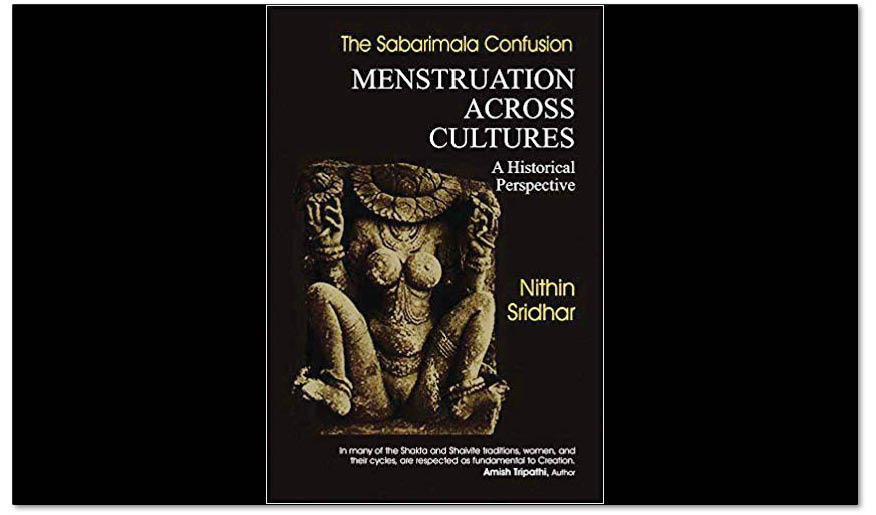New Delhi: This is an amazing book on an unlikely topic. Menstruation is a natural process, but isn’t usually mentioned, unless an issue like Sabarimala has rendered it topical. How does Hinduism look at menstruation? Here is Nithin Sridhar in his own words, from the Introduction. “Thus, India’s contemporary discourse around menstruation, sanitation needs, and associated women’s health has been reduced to positing: 1. India as a country with lack of access to hygienic menstrual products and practices; 2. Indian cultural beliefs and practices, especially those derived from Hindu traditions as regressive and patriarchal.”
The Introduction has a counterview on (1), but the book is about (2). On (2), “The present book seeks to undertake a detailed examination of menstrual notions and practices prevalent in Hinduism and other Indic traditions like Buddhism, Jainism, and Sikhism. It further does a comparative analysis of Hindu menstrual notions with notions prevalent in Abrahamic religions, ancient western polytheistic civilisations and other indigenous cultures from across the globe.” Indeed, it is a detailed and researched examination across six chapters, plus an Introduction and a Conclusion. (For some odd reason, the chapters aren’t numbered.) The bulk of the book, and the richest section, is about the Hindu view.
That Hindu view figures in the extensive and well-researched first chapter, peppered with examples from diverse strands. What does it all add up to? We find the answer in the sixth chapter, titled “Menstruation Attitude: Hinduism vs Modernity”. “In contrast to this (modernity), Hindu tradition promotes a positive notion, and asks women to perceive menstruation as a period of rest, austerity and self-purification, and as a privilege available only to them…Though it does associate menstruation with Ashaucha, it recognises it as a part of honouring this feminine process as a tapas, like the austerity of the yogis, a sacred cleansing, uniquely available to women. The cultural practices are designed to free women from the obligation of routine work and chores, and they offer seclusion as a form of spiritual retreat. More importantly, Hinduism celebrates menstruation as a sacred festival, and promotes a holistic view by aligning it with various ecological and cosmic principles.” This is a most remarkable proposition and most people will not have thought of menstruation, that is the Hindus’ view of menstruation, in quite this way. Notice that I am using the word “proposition”, not a “hypothesis”, because the hypothesis has been backed up with empirical evidence.
When I read, and re-read, the book, I had two niggling doubts and am still unsure about either. First, what should be the style of writing, academic or popular? This is a book that should have a popular readership. However, the present version is academic, without taking it all the way through. For instance, the first chapter is titled, “Hindu View of Menstruation”. The end-notes are combined with a bibliography. But within the chapter, the numbering of end-notes is separate for each section, which seems rather odd. Within that first chapter, there is a section titled “Yogic & Ayurvedic Perspectives on Menstruation” and this quotes from Section 184, Shanti Parva, Mahabharata.
The end-note says Kisari Mohan Ganguli translation and refers to the site where one can access the translation. Had this been academic all the way through, in addition to Section (Ganguli uses the word “Section” for Chapter), the exact verse would have been cited. Especially for texts, with a purist’s academic style, more specificity might have been better. The style of writing falls just short. In any event, Sridhar should probably think of a popular version too. Second, the meat of the book is in the Hindu view. Should one have broadened the canvas to include Abrahamic religions, ancient Western civilisations and indigenous communities? I have my doubts.
There is a reason why the author does it. That is because he wants to add a second proposition. “In our examination of various cultures, traditions, and religions of the world, we noticed how most cultures and communities attached some notion of impurity and sacredness to menstruation. While polytheistic cultures have understood menstruation in terms of lack of vitality and incompetence, monotheistic religions have associated menstruation with the notion of Original Sin… Modernity, on the one hand, relies heavily on a positivistic and materialistic worldview, promoted by a modern, scientific narrative, and, on the other hand, it has inherited certain misogynistic views from Abrahamic religions like Christianity. It also desacralizes menstruation, and delegitimises the cultural experiences and the knowledge about menstruation prevalent in traditional societies, especially among non-western polytheistic cultures, by branding them as primitive knowledge as against western scientific understanding.”
Notice I have used the word “proposition”, not “hypothesis”, again. Nevertheless, I do have that niggling doubt about whether the book should have retained its focus on the first proposition and left the second proposition to be fully developed in a subsequent volume. But who can disagree with the author’s last words? “After all, Hinduism is the last surviving and still flourishing ancient civilisation. One such attempt is made in this book and it is the hope of the author that this will pave the way for further research in this direction.”
Whether you are interested in pursuing that research or not, please do read this wonderful book.
Bibek Debroy, a renowned economist, scholar and translator, is chairman of Economic Advisory Council to the PM. As a translator, he is best known for his magnificent rendition of the Mahabharata in 10 volumes and the three-volume translation of the Valmiki Ramayana. He has just come out with the English translation of The Bhagavata Purana.

